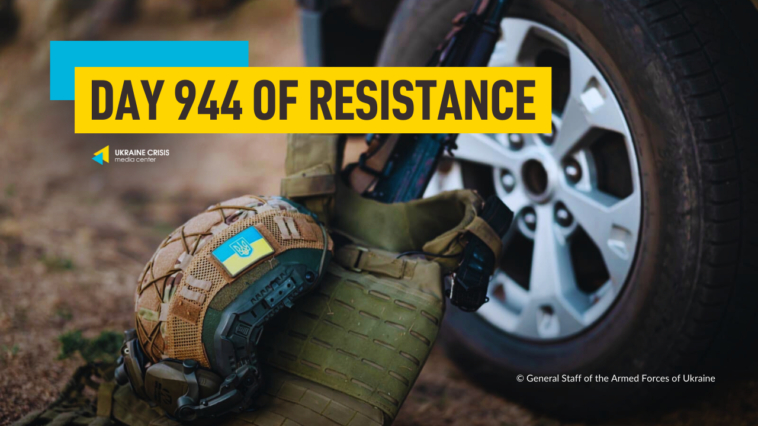The war with Russia is closer to the end than many people think — Zelenskyi; what the air strikes on Zaporizhzhia with KAB guided bombs used for the first time during the invasion mean and what bombs the Russian Federation is using — ISW; Russian troops have probably started using Chinese armored vehicles at the front — Bild.
The war with Russia is closer to the end than many people think — Zelenskyi
According to Ukrainian President Volodymyr Zelenskyi, the war with Russia is “closer to the end” than many people think. He also called on allies to more actively support the Ukrainian army.
Zelenskyi said this in an interview with the ABC News channel.
“The plan for victory is to strengthen Ukraine. That is why we are asking our friends, our allies to strengthen us. This is very important. I think we are closer to peace than we think. We are closer to the end of the war,” he said.
Besides, the President of Ukraine emphasized that the Russian dictator Vladimir Putin is afraid of the operation of the Armed Forces of Ukraine in the Kursk region.
“It’s true. He is very afraid. Why? Because his people saw that he couldn’t defend — that he couldn’t defend all his territory,” he added.
A new danger. What the airstrikes on Zaporizhzhia with KAB guided bombs used for the first time during the invasion mean and what bombs the Russian Federation is using — ISW
Russia conducted KAB guided bomb strikes on Zaporizhzhia for the first time overnight on September 22 to 23. This is a new dangerous development of Russian capabilities in the use of guided aerial bombs.
This is stated in a new summary of the Institute for the Study of War.
Overnight on September 22 to 23, Russia conducted up to seven airstrikes with KAB guided bombs on Zaporizhzhia, damaging 13 residential buildings and two educational facilities, and injuring at least 22 civilians. And on the evening of September 23, Russian troops conducted another strike on a critical infrastructure facility in Zaporizhzhia.
According to ISW experts, some Russian and Ukrainian sources claimed that Russian forces did not use KAB glide bombs, which are largely guided but rather used FAB-250 bombs equipped with unified planning and correction modules (UMPCs). [On September 20, the spokesman of the Ukrainian Volunteer Army South, Serhiy Bratchuk, confirmed that the Russian army began using aerial bombs with a planning and correction module, in particular FABs, in the Zaporizhzhia sector].
According to ISW, Soviet-era FAB bomb variants are largely unguided, and other iterations of Russian FABs with UMPCs have been unguided, though it is unclear whether the glide bombs that struck Zaporizhzhia on September 22 had guidance systems.
Russian KAB bombs have a glide range of 40-60 kilometers, and Zaporizhzhia is roughly 25-35 kilometers from the current frontline in the western Zaporizhzhia region. Russian milbloggers celebrated these strikes as an inflection in Russian strike capabilities and called on Russian forces to target logistics assets near the city, including bridges across the Dnipro River.
ISW analysts emphasize that Ukrainian forces are only able to counter the threat of Russian glide bombs by shooting down the aircraft that launch them, further demonstrating Ukraine’s need for increased air defense capabilities on the frontline and in near rear areas.
Russian troops have probably started using Chinese armored vehicles at the front — Bild
Photos of the occupiers with the Chinese ZFB-05 armored vehicle began to spread through Russian Telegram channels. The posts claimed that the vehicles were used in a war zone.
Bild’s open data analyst Julian Röpke confirmed the authenticity of the photos and writes that this is the first evidence of the use of Chinese military vehicles in Ukraine.
The Russian army used Chinese armored vehicles of the ZFB-05 type in Ukraine for the first time. China denies that it supplied them to Russia. “However, there are many African intermediaries that Russia could use,” Röpke writes.
It should be reminded that in October 2023, the Pentagon stated that the Russian Federation purchased dual-use products and secondary military items for the Russian military in China, in particular, small arms, spare parts, navigation equipment and protective equipment.
On April 7, 2024, the Bloomberg agency reported that China increased its support for Russia in the war against Ukraine, providing the aggressor country with satellite images for strikes on Ukrainian targets.
On April 12, the Reuters agency, citing unnamed American officials, reported that China continues to help Russia increase defense production by supplying machine tools, microelectronics, UAVs, and cruise missile technologies.
U.S. Deputy Secretary of State Kurt Campbell stated that the US will hold China responsible if Russia succeeds in the war against Ukraine.
The Ministry of Foreign Affairs of China stated that Beijing is not trying to profit from the war started by Russia in Ukraine.
After the NATO summit in Washington in July, in the final declaration, China was called a “decisive factor” contributing to the Russian Federation’s war against Ukraine. The Chinese delegation to the EU said that such claims were slander and also called on the alliance to stay away from Asia.
In the late July, the former Minister of Foreign Affairs of Ukraine, Dmytro Kuleba, visited China for the first time since the beginning of the full-scale war. According to him, following the negotiations with his Chinese colleague Wang Yi in Guangzhou, he received a clear signal that China is not looking for “temporary solutions” to the issue of peace in Ukraine.
President of Ukraine, Volodymyr Zelenskyi, stated that China had confirmed that it would not supply weapons to Russia and that it supports the territorial integrity of Ukraine.

